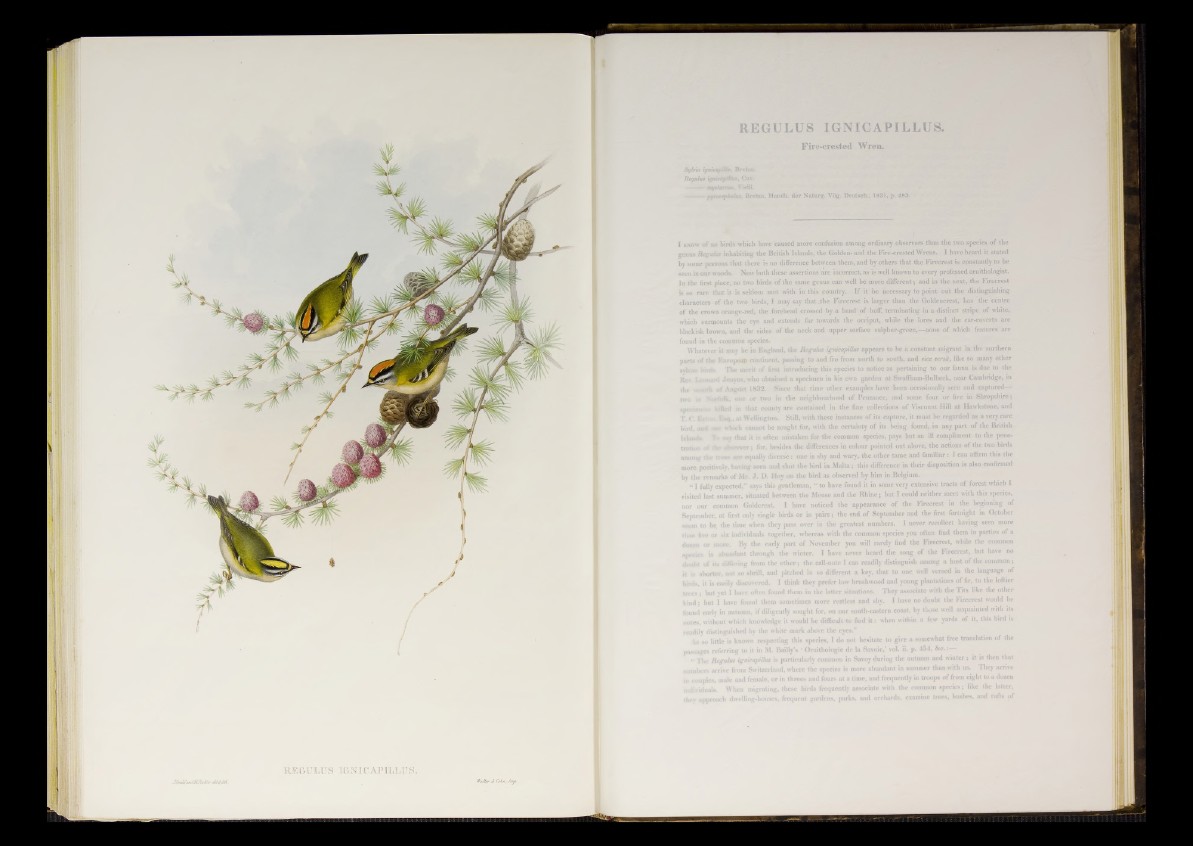
REGULUS IGNICAPILLUS .
Fire-crested Wren.
Sylvia ignicapiU«. Br ehm.
Regulus ignicetpUbt*, C u t .
myrtae&tv, Vieill.
pyrocepteba, Brehm. Handb. der Naturg. Vög. Deutsch., 1831, p. 483.
I k n ow of no birds which have caused more confusion among ordinary observers than the two species of the
genus Regulvs inhabiting the British Islands, the Golden- and the Fire-crested Wrens. I have heard it stated
by some persons that there is no difference between them, and by others that the Firecrest is constantly to be
seen in our woods. Now both these assertions are incorrect, as is well known to every professed ornithologist.
In the first place, no two birds of the same genus can well be more different; and in the next, the Firecrest
is so rare that it is seldom met with in this country. I f it be necessary to point out the distinguishing
characters o f the two birds, I may say that .the Firecrest is larger than the Goldencrest, has the centre
o f the crown orange-red, the forehead crossed by a band" of buff, terminating in a distinct stripe of white,
which surmounts the eye and extends far towards the occiput, while the lores and the ear-coverts are
blackish brown, and the sides of the neck and upper surface sulphur-green,—none of which .features are
found in the common species.
Whatever it may be in England, the Regains ignicapilhu appears to be a constant migrant in the northern
parts of' the European continent, passing to and fro from north to south, and vice versa, like so many Other
svivao The merit of first introducing this species to notice as pertaining to our fauna is due to the
Rev. Leonard Jenyas, who obtained a specimen in his own garden at Swaffham-Bulbeck, near Cambridge, in
the imoth of Augtfst 1832. Since that time other examples have been occasionally seen and captured—
two to Norfolk, one or two in the neighbourhood of Penzance, and some four or five in Shropshire;
specimen* killed in that county are contained in the fine collections of Viscount Hill at Hawkstone, and
T. C. iv- txuft. Esq., at Wellington. Still, with these instances of its capture, it must be regarded as a very rare
bird, and oe* which cannot be sought for, with the certainty of its being found, in any part of the British
Island*. To say that it is often mistaken for the common species, pays but an ill compliment to the pene-
tratit« (rf the observer; for. besides the differences in colour pointed out above, the actions of the two birds
among the tree# are equally diverse: one is shy and wary, the other tame and familiar: OUIVUK *««. —--------—---- J--- ------------- J «f - I can affirm this the
more positively, having seen and shot the bird in Malta; this difference in their disposition is also confirmed
by the remarks of Mr. J . D. Hoy on the bird as observed by him in Belgium.
“ I fully expected,” says this gentleman, “ to have found it in some very extensive tracts of forest which I
visited last summer, situated between the Meuse and the Rhine; but I could neither meet with this species,
nor our common Goldcrest. I have noticed the appearance of the Firecrest in the beginning of
September, at first only single birds or in pairs; the end of September and the first fortnight in October
seem to be. the time when they pass over in the greatest numbers. I never recollect having seen more
j}..,.. five or six individuals together, whereas with the common species you often find, them in parties of a
dozen or more. By the early part of November you will rarely find the Firecrest, while the common
species is abundant through the winter. I have never heard the song of the Firecrest, but have no
doubt of its differing from the o th er; the eall-note I can readily distinguish among a host of the common;
it shorter, not so shrill, and pitched in so different a key, that to one well versed in the language of
birds, it is easily discovered. I think they prefer low brushwood and young plantations of fir, to the loftier
tre e s ; but yet I have often found them in the latter situations. They associate with the Tits like the other
kind; but I have found them sometimes more restless and shy. I have no doubt the Firecrest would be
found early in autumn, if diligently sought for, on our south-eastern coast, by those well acquainted with its
notes, without which knowledge it would be difficult'to find i t : when within a few yards of it, this bird is
readily distinguished by the white mark above the eyes.”
As so little is known respecting this species, I do not hesitate to give a somewhat free translation of the
passages referring to it in M. Bailly’s ‘ Ornithologie de la Savoie,’ vol. ii. p. 454, &c.:
“ i he Regains ignicapillus is particularly common in Savoy during the autumn and winter; it is then that
dumbers arrive from Switzerland, where the species is more abundant in summer than with us. They arrive
in couples, male and female, or in threes and fours at a time, and frequently in troops of from eight to a dozen
individuals. When migrating, these birds frequently associate with the common species; like the latter,
»hcv approach dwelling-houses, frequent gardens, parks, and orchards, examine trees, bushes, and tufts pf